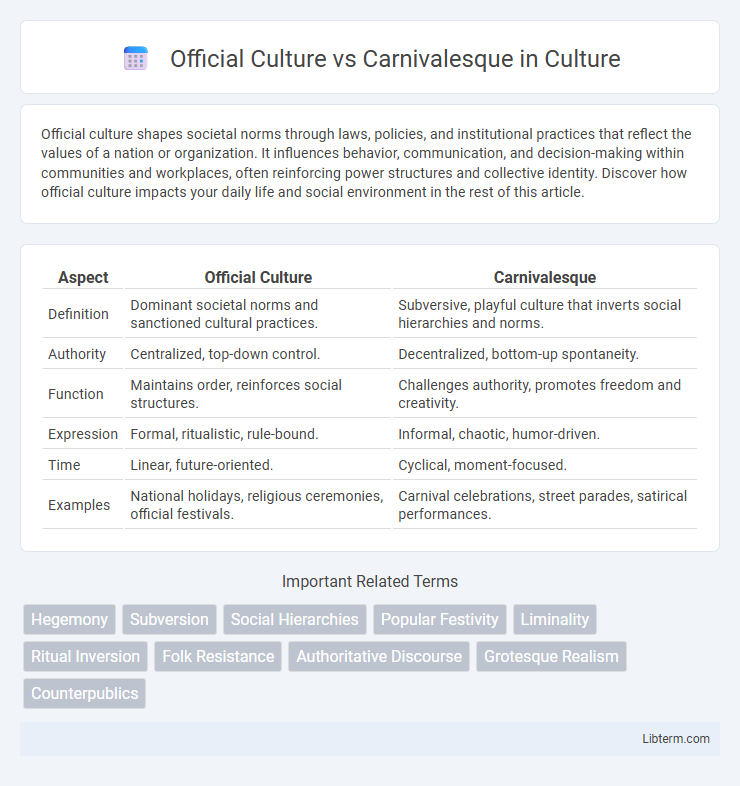Official culture shapes societal norms through laws, policies, and institutional practices that reflect the values of a nation or organization. It influences behavior, communication, and decision-making within communities and workplaces, often reinforcing power structures and collective identity. Discover how official culture impacts your daily life and social environment in the rest of this article.
Table of Comparison
| Aspect | Official Culture | Carnivalesque |
|---|---|---|
| Definition | Dominant societal norms and sanctioned cultural practices. | Subversive, playful culture that inverts social hierarchies and norms. |
| Authority | Centralized, top-down control. | Decentralized, bottom-up spontaneity. |
| Function | Maintains order, reinforces social structures. | Challenges authority, promotes freedom and creativity. |
| Expression | Formal, ritualistic, rule-bound. | Informal, chaotic, humor-driven. |
| Time | Linear, future-oriented. | Cyclical, moment-focused. |
| Examples | National holidays, religious ceremonies, official festivals. | Carnival celebrations, street parades, satirical performances. |
Defining Official Culture and the Carnivalesque
Official culture embodies the dominant societal norms, values, and ideologies enforced through institutions, rituals, and sanctioned expressions that maintain social order and hierarchy. The carnivalesque, conceptualized by Mikhail Bakhtin, represents a subversive, chaotic mode of expression that inverts traditional power structures through humor, parody, and the suspension of conventional norms. These opposing frameworks highlight the tension between structured authority and liberating transgression within cultural practices.
Historical Roots of Official Culture
The historical roots of official culture trace back to centralized institutions reflecting dominant power structures, often codified through state, religious, and educational systems that enforce conformity and hierarchy. Official culture emphasizes order, tradition, and sanctioned norms, shaping collective identity via formal rituals, canonical texts, and state-sponsored symbols. This institutional framework contrasts with the carnivalesque, which emerges from the subversion of these official norms through popular festivities, humor, and inversion of social roles.
Origins and Evolution of the Carnivalesque
The carnivalesque originated in medieval Europe as a subversive cultural phenomenon that inverted official culture's rigid hierarchies through humor, chaos, and bodily excess. Rooted in folk festivals and the carnivals of the Middle Ages, it evolved as a space where social norms were temporarily suspended, allowing marginalized voices to critique authority. Mikhail Bakhtin's concept of the carnivalesque highlights its role in destabilizing dominant ideologies, fostering creative expression, and influencing modern literature, theater, and popular culture.
Power Structures in Official Culture
Official culture enforces power structures through institutional norms, promoting hierarchy, authority, and conformity to maintain social order. It controls discourse by legitimizing dominant ideologies and marginalizing subversive voices. This systemic power contrasts with carnivalesque culture, which subverts authority through satire, inversion of social roles, and liberation from established hierarchies.
Subversion and Laughter in the Carnivalesque
Carnivalesque culture subverts Official Culture by inverting established hierarchies and norms through humor and chaos, creating a temporary space where social order is mocked and questioned. Laughter in the Carnivalesque serves as a powerful tool of resistance, undermining authority and enabling collective freedom by breaking down fear and imposing symbolic equality. This form of subversion destabilizes dominant ideologies, fostering critical reflection and promoting social change through celebration and irreverence.
Official Rituals vs. Popular Festivities
Official rituals often emphasize hierarchical structure, formal symbolism, and uniformity, serving to reinforce state power and collective identity through prescribed ceremonies. In contrast, popular festivities embrace spontaneity, humor, and subversion, allowing communities to express resistance, creativity, and social critique outside institutional confines. The tension between these modes reveals how cultural practices negotiate authority, identity, and social cohesion in diverse societies.
Social Control and Resistance
Official culture enforces social control by promoting dominant norms, values, and institutions that maintain power structures and social order. Carnivalesque subverts these norms through humor, chaos, and inversion of hierarchies, providing a space for resistance and critique of authority. This tension between official culture and carnivalesque highlights the dynamic interplay between domination and social contestation in society.
Art, Literature, and the Carnivalesque Tradition
Official culture in art and literature emphasizes established norms, hierarchy, and sanctioned aesthetics, often reinforcing dominant social narratives. The carnivalesque tradition subverts these conventions through humor, chaos, and grotesque imagery, enabling marginalized voices and alternative perspectives to flourish in creative expression. This tension between official culture and the carnivalesque fosters dynamic dialogue within literary works and artistic practices, challenging authority and expanding cultural horizons.
Contemporary Examples and Impacts
Contemporary examples highlight Official Culture through institutions like museums, government ceremonies, and mainstream media, which uphold dominant social norms and values promoting order and authority. In contrast, Carnivalesque manifests in street festivals, viral internet memes, and protest performances that subvert power structures by embracing chaos, satire, and humor. The impact of this dynamic tension fosters social critique, cultural innovation, and contestation between institutional control and grassroots expressions in modern societies.
Reconciling Official Culture and the Carnivalesque
Reconciling official culture and the carnivalesque involves integrating the structured norms and values of institutionalized society with the subversive, liberating elements of carnivalesque expression. This process fosters a dynamic cultural dialogue that challenges hierarchy and promotes social transformation by allowing spaces for parody, chaos, and inversion within formal cultural frameworks. Recognizing the carnivalesque's role in questioning authority can enrich official culture through critical reflection, creativity, and inclusivity.
Official Culture Infographic

 libterm.com
libterm.com